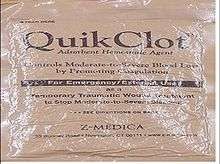QuikClot

QuikClot is an antihemorrhagic/hemostatic agent produced by Z-Medica.
Background
QuikClot was originally available as a powder to be poured directly on a wound to stem bleeding. It absorbed the water in the blood, thus increasing its already present clotting capabilities, while also activating Platelets. Later it was formulated using zeolite beads, which promoted clotting directly through activation of the coagulation cascade. The most current formulation is a kaolin coated gauze which works directly to promote blood clotting by activating ‘’factor XII’’ of the coagulation cascade.[1] Currently the QuikClot products are produced using both the zeolite and kaolin formulations.
Zeolite Products
The original formulation of the first generation product contained the active ingredient zeolite, which promoted blood clotting. The Zeolite reaction with blood was exothermic, releasing heat during the clotting process, which could cause second degree burns. Because of this, the product was not available for retail but was only used in emergency scenarios, such as in combat. Newer zeolite formulas come pre-hydrated, which produce less heat, and can be used more safely to pack wounds and stop hemorrhage.
Kaolin Products
The most current generation of QuikClot products use a mineral known as kaolin, which replaces zeolite as the active clotting agent. ‘’’Kaolin’’’ is an inert, naturally occurring inorganic mineral which has been proven to promote clotting by activating ‘’factor XII’’ of the coagulation cascade. [2] The product consists of a non-woven gauze coated in kaolin which can be applied to the region of trauma to promote clotting without an exothermic reaction. Originally sold as QuikClot Combat Gauze, the product now has a variety of packaging options available for military, law enforcement, EMS, and hospital use. Consumer versions of the product, which use the same kaolin formulation, are also available at a variety of retailers.
Clotting Mechanisms and Validation
Using zeolite as a clotting agent was discovered by Frank Hursey (Z-Medica co-founder) in 1984.[3] Following the September 11 attacks the US armed forces conducted a series of tests comparing different antihemorrhagic technologies, in which QuickClot got the best score.[4][5] Following these tests, the US armed forces approved its use in Afghanistan and Iraq. QuikClot Combat Gauze utilizes the clotting properties of kaolin to help control and stop bleeding. Kaolin works by activating ‘’factor XII’’, a protein factor which assists in the initiation of the coagulation cascade, a protein chain reaction which promotes blood clotting as a result of trauma. The active nature of kaolin in the promotion of this process causes it to happen much earlier on than normal, but also at a faster rate.[6][7] In 2008, QuikClot Combat Gauze with kaolin was chosen by the CoTCCC( (Committee on Tactical Combat Casualty Care) as the only hemostatic dressing to be used by all branches of the US military for compressible hemorrhage not amenable to tourniquet use or as an adjunct to tourniquet removal if evacuation time is anticipated to be longer than 2 hours.[8] Today, QuikClot Combat Gauze is still the hemostatic device of choice of all branches of the military by the CoTCCC. The Department of Defense is funding research to explore other applications of QuikClot products in bleeding associated with traumatic injuries.
References
- ↑ Dee KC, Puleo DA, Bizios R. Tissue-Biomaterial Interactions. Hoboken: Wiley & Sons, 2002.
- ↑ Lamb KM, Pitcher HT, Cavarocchi NC, Hirose H. Vascular site hemostasis in percutaneous extracorporeal membrane oxygenation therapy. Open Cardiovasc Thorac Surg J. 2012;5:8-10.
- ↑ U.S. patent number 4,822,349, 1989
- ↑ "Application of a Zeolite Hemostatic Agent Achieves 100% Survival in a Lethal Model of Complex Groin Injury in Swine," – J Trauma. 2004;56:974–983, Hasan B. Alam, MD
- ↑ "Comparative Analysis of Hemostatic Agents in a Swine Model of Lethal Groin Injury" – J Trauma. 2003;54:1007–1082, Hasan B. Alam, MD
- ↑ Trabattoni D, Montorsi P, Fabbiocchi F, Lualdi A, Gatto P, Bartorelli A. A new kaolin-based haemostatic bandage compared with manual compression for bleeding control after percutaneous coronary procedures. Eur Radiol. 2011;21:1687-1691.
- ↑ Politi L, Aprile A, Paganelli C, et al. Randomized clinical trial on short-time compression with kaolin-filled pad: a new strategy to avoid early bleeding and subacute radial artery occlusion after percutaneous coronary intervention. J Interven Cardiol. 2011;24:65-72.
- ↑ Tactical Combat Casualty Care Guidelines 2 June 2014. http://www.usaisr.amedd.army.mil/pdfs/TCCC_Guidelines_140602.pdf.[] Accessed March 25, 2015.